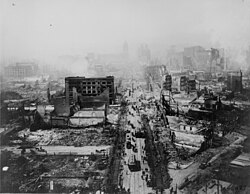
Back Aardbewing Afrikaans Erdbeben ALS የመሬት መንቀጥቀጥ Amharic Tierratremo AN Eorþbeofung ANG भूकंप ANP زلزال Arabic ভূমিকম্প Assamese Terremotu AST भूकम्प AWA

An earthquake is when Earth's tectonic plates shake and move Earth's surface. Strong earthquakes damage buildings.
Disturbances in the Earth cause earthquakes. Different tectonic plates are slowly moving. When they get stuck, tension builds up in them. Earthquakes occur when tectonic plates suddenly break free, so they start moving quickly. The first point of an earthquake's rupture is called its hypocenter or focus. The epicenter is the point at ground level directly above the hypocenter.
People who study earthquakes are called seismologists. Many earthquakes can occur in a small area in a short period of time. The sudden release of stress in the tectonic plates sends waves of energy that travel through the Earth. Seismology studies the cause, recurrence, type and magnitude of earthquakes.
The effect of an earthquake can be measured with a seismometer. A seismometer detects the tremors of the earth and plots the tremors on a seismograph. The strength or magnitude of an earthquake can be measured using the Richter scale. The Richter scale was invented by Charles Francis Richter in 1935. The scale is numbered 0-10. A 2 on this scale is a tremor that is not easily recorded. And damage of size 5 (or more) in a wide area. The largest earthquake ever measured had a magnitude of 9.5.
No one can tell when an earthquake will happen. But we know where earthquakes are likely to occur in the future, such as near fault lines. An earthquake under the ocean can create a huge wave called a tsunami. Tsunamis can also cause a lot of destruction.